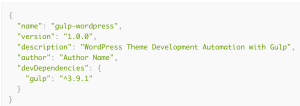This article recently appeared in the SitePoint Tribune, a weekly newsletter published by SitePoint.com To have articles like this delivered straight to your inbox, enter your email address in the subscription box below…
Mark Walmsley is the Managing Director of WebProjects — a UK-based media company that provides Web design and newsletter publishing services.
Mark originally trained as a freelance percussionist in London for 4 years, fully intending to take up a full time position in a London orchestra. However, in college, Mark picked up the entrepreneurial bug! He started Music Plus — an entertainment agency that booked music students into paid work at London parties, business events and store promotions.
One thing led to another, and Mark started working to build his own Web design company part-time, while running Music Plus. “I can’t stress enough the importance of keeping as much existing income as possible during the early stages,” Mark says. While he still owns his entertainment agency, Mark’s sole focus these days is his Web design business, WebProjects. But he doesn’t take on just any old Web design job – Mark’s company builds only classical music sites.
Niche Marketing – It’s a Classic!
Why the niche focus? Early on, Mark put out a wide net for clients – he even sent one of his employees driving all over the country to visit shipping companies and travel agents, few or which were interested in spending money on the untested medium of the Internet.
“The business that was out there was being snapped up by larger companies,” Mark explains. “So I decided that we should concentrate on a niche, and, as we were already doing some classical music Websites, that became our niche.”
Mark got his first client on a trip to Japan, when he struck up a conversation with the Marketing Manager for the City of Birmingham Symphony Orchestra (CSBO). Mark got his competitive juices flowing (London Symphony Orchestra had yet to publish a Website), and he landed the project! The Marketing Manager went on to utilize Mark’s Web design services some months later, when he moved to a different position.
“The CBSO still retain us on a monthly basis, and we’ve redeveloped the site 4 times since we first built it,” notes Mark.
Expansion
In 1996 Mark took on a student named Ben Sauer as his sidekick. Ben continued to work for WebProjects through 6 years of studies at Warwick, and now, having obtained his degree, he’s a full-time programmer at the company.
Currently, the business is organized around four people: Mark, who drums up new business and promotes client Websites, Matthew Lindop, the Project/Account Manager, Andy Walker – the lead graphic and Web designer, and Ben Sauer, who’s head programmer and network manager.
“In effect, I get the new clients, Matt takes over, and then Andy and Ben get their hands dirty while Matt tries to keep the clients out of the way!” Mark quips.
Because business is so brisk, Mark has recently been forced to take on an office assistant, a second graphic designer, and a second programmer. All three work part-time for the company.
“We aim to keep the full time members of the team as busy as possible,” Mark explains. “Then, when the devil’s driving, we beef up the amount of part-time support we get, or outsource to specialist developers such as Flash programmers or Director experts.”
A Classical Client List
The market for classical music Websites doesn’t sound like a big one. So just how did Mark go about building his client list?
“We realised in 1997 that www.classicalmusic.co.uk was still available, so we snapped it up along with a few other choice classical domains. We also promoted OrchestraNET.co.uk heavily, and added a free page for each of the major orchestras in the UK. When those without their own Websites (which were most of them) searched for themselves at Yahoo!, they found us!
“We also started the first classical music Webring when Sage Weill was in charge, and it now boasts 750 classical sites, most of which link to us from their home pages,” boasts Mark.
“These days, WebProjects also has a pretty significant presence in the British Music Yearbook, the industry’s trade directory. We’re also looking at going into Musical America, the US equivalent. They also have a Google AdWords account that they use to promote themselves for selected keywords,” Mark explains.
“The other wonderful thing about identifying a niche is that your potential clients are easy to find. In our case, the vast majority of our target clients are listed in the British Music Yearbook.”
The WebProjects Strategy
After designing a site, what’s the next step for WebProjects? Getting clients to pay a monthly retainer, and, in the process, build a recurring income stream without constantly having to find new clients.
“We persuaded many companies that we did work for that they didn’t have the time or knowledge to keep the site updated as it needed to be,” says Mark of his business strategy. “We offered them our undivided attention one day per month for planned updates, and our divided attention for the rest of the month at a carefully pitched retainer — and they leaped at it.”
WebProjects hasn’t restricted itself to UK based clients, either… because of its unique niche, and the considerable marketplace knowledge contained within the firm, the WebProjects client base spans the globe, including clients in New Zealand, Canada, the USA and Scandinavia.
As an added income stream, WebProjects also promotes its clients’ Websites, and publishes email newsletters on behalf of many of their clients for a monthly fee.
“We’ve always explained to clients that publishing a Website is a passive marketing activity. It’s a little like printing brochures and leaving them outside your office in the hope that the right number and type of people come along and pick them up. For those clients who wish to attract the attention of people who haven’t already heard about them, our promotion and email newsletter publishing services are the key,” Mark says.
“In our sector, surplus concert tickets can also more easily be sold at short notice if an alert can be sent to an email address or mobile phone.
“Contract publishing has long been an established feature in print. Renault, for example, publish a monthly glossy magazine that they send to owners of Renault cars. However, the guys at Renault have very little to do with it. The project is outsourced to a company that’s owned by a neighbour of mine,” Mark explains.
“Under contract from Renault he edits the magazine, sells advertising space, commissions articles, arranges photo shoots and employs an art editor. He’s an expert in the field, and Renault trust him to produce a successful title for them each month. They have ultimate editorial control and set the guidelines, but there is now very little input from Renault.”
WebProjects have adopted this model for use with their own clients. But how do they set rates for Contract Web Publishing? The business’s regular hourly design and programming rates apply to the actual writing of the newsletter, but they also charge for one full day of research, and another day for adjustments, distribution, monitoring and reporting (for each issue).
And in case you’re wondering, WebProjects’ business has been growing at a rapid clip — 25% per year, with no end in sight!
Lessons Learnt
- Choose a niche, no matter how small it is, and focus on it: day in, and day out. Advertise in the relevant trade magazine or directory, and other key media for your niche.
- Consider building a free one-page site for each company in your niche that doesn’t currently have a Web presence… that way, when they search for themselves, they find you!
- Don’t stop at just building Websites! Get clients to pay you a monthly retainer for updates and changes.
- Be proactive about rebuilding Websites for clients as times change.
- Consider publishing newsletters for your clients on a monthly basis. There’s nothing quite as reassuring as recurring income — don’t base your business success on constantly having to find new clients.
 Matt Mickiewicz
Matt MickiewiczMatt is the co-founder of SitePoint, 99designs and Flippa. He lives in Vancouver, Canada.




